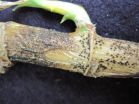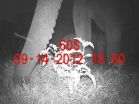(Press-News.org) GAINESVILLE, FL – The popularity of ornamental plants imported to the United States from China is accompanied by concerns about the potential to introduce pathogens into the market. Dracaena, a genus consisting of approximately 40 different species, including the widely recognized "lucky bamboo," is among the most frequently imported group of ornamentals to enter the U.S. for domestic sale and eventual export to Canada. The authors of a new research study say it is crucial to be vigilant about potential pests and pathogens on imported cuttings of Dracaena. "Pests and pathogens currently not in the United States could be imported with Dracaena plant materials," said Ariena H.C. van Bruggen, corresponding author of the study published in HortScience. Lucky bamboo (Dracaena sanderiana) with anthracnose symptoms was first found in Florida in 2009; the infection was associated with the fungus Colletotrichum dracaenophilum, a pathogen that originated in Asia.
The researchers evaluated the effects of hot water treatments on symptomless lucky bamboo planting material and tested fungicides for the control of Colletotrichum in asymptomatic, but infected, rooted cuttings as well as inoculated plants.
"The most important finding of our study was that the hot water treatments tested were not promising for the control of C. dracaenophilum latently present in lucky bamboo as plants become more susceptible at higher temperatures," the researchers said. The team also determined that seemingly healthy rooted cuttings of lucky bamboo introduced from China may carry C. dracaenophilum, which can induce anthracnose symptoms several months after arrival in the United States. "It is not known which environmental factors may trigger the appearance of symptom. However, in this study, lesions appeared on noninoculated stalks when irrigation intervals were lengthened. Thus, water stress may trigger the induction of symptoms," the authors said.
Remarkably, analyses showed that 25% to 43% of noninoculated lucky bamboo stalks included in the study contained the latent presence of Colletotrichum dracaenophilum. The authors determined that traditional hot water treatments such as those tested in the study were "not promising" for controlling the latent fungus, but noted that other temperature-time combinations could be tested in future studies. Application of the systemic fungicide Azoxystrobin was found to be effective both at preventing new infections by C. dracaenophilum and curing latent infections and anthracnose development on lucky bamboo plants.
The authors recommended implementation of a systems approach to address the problem, including: training and disease management at the source, careful inspection of plants at ports of entry, fungicide treatment of rooted cuttings to eliminate latent infection, and training and disease management in nurseries at lucky bamboo's destinations.
INFORMATION:
The complete study and abstract are available on the ASHS HortScience electronic journal web site: http://hortsci.ashspublications.org/content/49/4/453.abstract
Founded in 1903, the American Society for Horticultural Science (ASHS) is the largest organization dedicated to advancing all facets of horticultural research, education, and application. More information at ashs.org
Fungal infection control methods for lucky bamboo
Systems approach recommended for controlling latent Colletotrichum dracaenophilum
2014-06-23
ELSE PRESS RELEASES FROM THIS DATE:
Cautionary tales: Mustaches, home oxygen therapy, sparks do not mix
2014-06-23
Rochester, Minn. — Facial hair and home oxygen therapy can prove a dangerously combustible combination, a Mayo Clinic report published in the peer-reviewed medical journal Mayo Clinic Proceedings finds. To reach that conclusion, researchers reviewed home oxygen therapy-related burn cases and experimented with a mustachioed mannequin, a facial hair-free mannequin, nasal oxygen tubes and sparks. They found that facial hair raises the risk of home oxygen therapy-related burns, and encourage health care providers to counsel patients about the risk.
MULTIMEDIA ALERT: Video ...
Africa's poison 'apple' provides common ground for saving elephants, raising livestock
2014-06-23
VIDEO:
A five-year study led by Robert Pringle (above), a Princeton University assistant professor of ecology and evolutionary biology, suggests that certain wild African animals, particularly elephants, could be a boon...
Click here for more information.
While African wildlife often run afoul of ranchers and pastoralists securing food and water resources for their animals, the interests of fauna and farmer might finally be unified by the "Sodom apple," a toxic invasive plant ...
Back away, please
2014-06-23
In our long struggle for survival, we humans learned that something approaching us is far more of a threat than something that is moving away. This makes sense, since a tiger bounding toward a person is certainly more of a threat than one that is walking away.
Though we modern humans don't really consider such fear, it turns out that it still plays a big part in our day-to-day lives. According to University of Chicago Booth School of Business Professor Christopher K. Hsee, we still have negative feelings about things that approach us — even if they objectively are not ...
Wearable computing gloves can teach Braille, even if you're not paying attention
2014-06-23
Several years ago, Georgia Institute of Technology researchers created a technology-enhanced glove that can teach beginners how to play piano melodies in 45 minutes. Now they've advanced the same wearable computing technology to help people learn how to read and write Braille. The twist is that people wearing the glove don't have to pay attention. They learn while doing something else.
"The process is based on passive haptic learning (PHL)," said Thad Starner, a Georgia Tech professor and wearable computer pioneer. "We've learned that people can acquire motor skills ...
Can magnetic fields accurately measure positions of ferromagnetic objects?
2014-06-23
Many creatures in nature, including butterflies, newts and mole rats, use the Earth's inherent magnetic field lines and field intensity variations to determine their geographical position. A research team at the University of Minnesota has shown that the inherent magnetic fields of ferromagnetic objects can be similarly exploited for accurate position measurements of these objects. Such position measurement is enabled in this research by showing that the spatial variation of magnetic field around an object can be modeled using just the geometry of the object under consideration. ...
Breakthrough drug-eluting patch stops scar growth and reduces scar tissues
2014-06-23
Scars — in particular keloid scars that result from overgrowth of skin tissue after injuries or surgeries — are unsightly and can even lead to disfigurement and psychological problems of affected patients. Individuals with darker pigmentation — in particular people with African, Hispanic or South-Asian genetic background — are more likely to develop this skin tissue disorder. Current therapy options, including surgery and injections of corticosteroids into scar tissues, are often ineffective, require clinical supervision and can be costly.
A new invention by researchers ...
D-Wave and predecessors: From simulated to quantum annealing
2014-06-23
The D-Wave computer is currently the latest link of a long chain of computers designed for the solution of optimization problems. In what sense does it realize quantum computation? We describe the evolution of such computers and confront the different views concerning the quantum properties of the D-wave computer.
Quantum algorithms show several benefits over classical ones. One strong example suggested by Shor in 1994 is the ability to factor numbers which can be effectively done on a quantum computer but is very hard on a classical computer. However, the actual model ...
New data bolsters Higgs boson discovery
2014-06-23
If evidence of the Higgs boson revealed two years ago was the smoking gun, particle physicists at Rice University and their colleagues have now found a few of the bullets.
The European Organization for Nuclear Research (CERN) published research in Nature Physics this week that details evidence of the direct decay of the Higgs boson to fermions, among the particles anticipated by the Standard Model of physics.
The finding fits what researchers expected to see amid the massive amount of data provided by the Large Hadron Collider (LHC). The world's largest collider smashed ...
MIT researchers unveil experimental 36-core chip
2014-06-23
CAMBRIDGE, MA -- The more cores — or processing units — a computer chip has, the bigger the problem of communication between cores becomes. For years, Li-Shiuan Peh, the Singapore Research Professor of Electrical Engineering and Computer Science at MIT, has argued that the massively multicore chips of the future will need to resemble little Internets, where each core has an associated router, and data travels between cores in packets of fixed size.
This week, at the International Symposium on Computer Architecture, Peh's group unveiled a 36-core chip that features just ...
Anti-androgen therapy for triple-negative breast cancer may benefit lower-androgen tumors
2014-06-23
Triple-negative breast cancers do not benefit from the targeted therapies that have greatly improved the survival of patients with other subtypes of breast cancer. But recent work shows that while these cancers lack estrogen receptors, progesterone receptors, and aren't driven by the gene HER2, up to a third of these tumors express the androgen receptor – clinical trials are underway to inhibit the androgen receptor in these tumors in much the same way that the drug Tamoxifen inhibits estrogen receptor in estrogen-receptor-positive breast cancers. A new University of Colorado ...
LAST 30 PRESS RELEASES:
Studies investigate how AI can aid clinicians in analyzing medical images
Researchers pitch strategies to identify potential fraudulent participants in online qualitative research
Sweeping study shows similar genetic factors underlie multiple psychiatric disorders
How extreme weather events affect agricultural trade between US states
Smallholder farms maintain strong pollinator diversity – even when far from forests
Price of a bot army revealed across hundreds of online platforms worldwide – from TikTok to Amazon
Warblers borrow color-related genes from evolutionary neighbors, study finds
Heat signaling from plants is an ancient pollinator signal
New index reveals the economics underlying the online manipulation economy
High-resolution satellite observations reveal facility-level methane emissions worldwide
Researchers discover how Ebola and Marburg disrupt the gastrointestinal tract
Feeling the heat
Eastward earthquake rupture progression along the Main Marmara Fault towards Istanbul
Scientists uncover how Earth’s mantle locked away vast water in early magma ocean
Scientists uncover key driver of treatment-resistant cancer
Rare image of Tatooine-like planet is closest to its twin stars yet
Music: Popular song lyrics have become more negative since 1973
Marine ecology: Killer whales tail dolphins to hunt salmon
ADHD prescriptions on the rise, study finds
How to build a genome
Sharp rise in ADHD stimulant prescriptions in Ontario, research finds
Trends and prevalence of the metabolic syndrome among US adults
Population-level trends in ADHD medication prescribing
Missing piece of myelin disturbs the brain’s rhythm
Insilico Medicine and Taigen achieves license agreement to develop and commercialize AI-driven PHD inhibitor for anemia of Chronic Kidney Disease (CKD)
Exploring dominant endophytic Pleosporales in grasses: New taxonomic insights in the suborder Massarineae
Comparative transcriptomic analysis of human maxillary and mandibular tooth germs reveals discrepancies in gene expression patterns
Scientists detect atmosphere on molten rocky exoplanet - study
Chip-scale magnetometer uses light for high-precision magnetic sensing
Illinois Tech biomedical engineering professor Philip R. Troyk elected as Fellow of the National Academy of Inventors
[Press-News.org] Fungal infection control methods for lucky bambooSystems approach recommended for controlling latent Colletotrichum dracaenophilum




